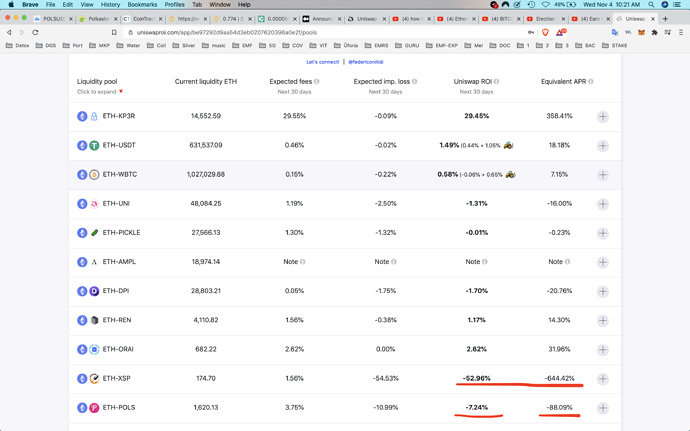Hi
Im looking at the Uniswap ROI page and trying to understand the negative ROI. I can’t seem to wrap my head around what that means. If youre losing money why would anyone want to provide liquidity?
Sorry if its an obvious stupid question
This could be confusing indeed, I have some ETH/UNI LP but on mooniswap, I’m not losing tokens or something like that, maybe should be good to ask how that website measure those stats, how their calculated, it could be a calc error.
Carlos Z
In my experience when you provide liquidity, (I use Uniswap) you loose control of your token original ratio to the contract, and that gives chances to negative ROI depending on the market value of your current liquidity status.
So, for example; if you start Original liquidity: 1 ETH and 160 UNI (Total value = $800.00 usd)
(assuming 1 ETH = 400 usd , and 1 UNI = 2.50 usd)
Then, let’s imagine a situation in where most people are using the pool to exchange UNI for ETH. This means the contract wants to keep the pool balanced and adjusts the liquidity.
This will translate, in an ideal world that you still have the same money worth but different ratio.
In our example it could be something like: now you have 0.90 ETH and 176 UNI (Total value STILL IDEALLY = $800.00 usd)
But we all now there is no such thing as perfect market, so prices are surely fluctuating.
If let’s say ETH is now worth $380 usd and UNI is worth $2.00 usd
Then your total liquidity is worth = 0.90 ETH (x$380 usd) + 176 UNI(x2.0 usd) = $694.00
And there you have a computation for a negative ROI.
So price fluctuations play a high role in all this. There is also the concept of impermanent loss, which is different but is other way you can loose potential value in your liquidity.
I am not an expert though, but so far this is how I have come to understand some of this.
I hope it helps and everybody feel free to correct me.
thanks for taking the time to try and explain this to me though it still doens’t make sense to me.
I wanted to try to provide liquidity with my POLS but if its projected a negative ROI why would anyone still go ahead and provide liquidity?
Im just starting to jump back into crypto after a year off or something and the space has grown so immensely… shouldn’t have stopped keeping up with the developments.
Amazing explanation @dcota, that is exactly part of the puzzle of how liquidity works, although that contract will calculate your position based on the ratio you deposit, but we have to keep in mind the market fluctuations (eth dumping and pumping lets say: 370$ to 400 $ and UNI from 2$ to 3$).
That well affect directly your LP (liquidity position) and ROI, some times negatively (like entering your LP at assuming 1 ETH = 400 usd , and 1 UNI = 2.50 usd) if price goes below, meaning you are loosing money, but when the price of both assets goes up, your LP also goes up, depending on the price and distribution ratio (51% ETH/49% UNI for example) you will end up with more tokens on one of those sides, also with some profits (which we could define has the interest payed through our participation on the Pool).
I’m still learning how this works perfectly, this are really complex things from probably finance that we also need to learn to get an idea on how this Liquitidy Pools works. But i think this are more likely Long Term Strategies to make money, because this LP could take time to goes into a good amount of profits (I would not use 800$ to get 8$ of profits, reward < risk).
So at least from my personal perspective, this are strategies for long term, whit a high risk involved (bugs on contracts, horrible Liquidity Pools or Pairs…). Also i’m not an expert, just another student learning and researching  . This is only my non-professional opinion about this amazing Space called DeFi.
. This is only my non-professional opinion about this amazing Space called DeFi.
Carlos Z
It goes to Gresham’s Law, that bad money drives good out of circulation. My very limited experience with providing liquidity has been that overall my stash loses value. I think the general caveat is that if both coins are stable the fees earned are worth the pooling. Otherwise, it’s a losing proposition.
An exception would be if a volatile coin crashes, you get more of that coin in your pool, and you pull out in time to profit when it recovers value. I actually gained some Honey this way. Now for the second part.
This is why yield farming was created: to reward liquidity providers.
At least that is my understanding.
NOTHING I say is financial advice, unless it’s learn blockchain coding.
I appreciate the feedback. I just tried joining a LP and thats what it seems like, that i was loosing value even thou it was paying out 156%. Im gonna watch it for a few more days.

